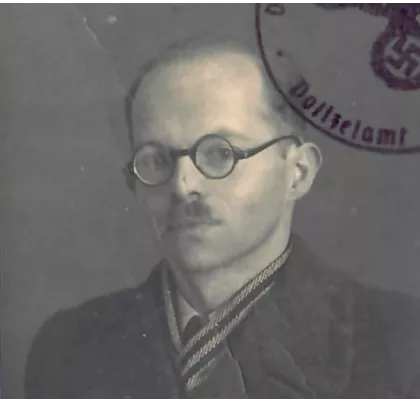Ernst Stimmer (1906-1990)
The civil engineer
- © Private
Ernst Stimmer was born to Emil and Irene Stimmer on 5 July 1906 in Vienna. His father was a bank clerk and his mother Irene was a pianist. Their second child was named Elsa. All four family members left the Jewish Community of Vienna in the 1920s/30s. Ernst and his family converted to Catholicism.
After graduating from secondary school, Ernst enrolled in a civil engineering degree at the Technical University Vienna in the academic year 1924/25. In November 1934, he was awarded the title of "engineer", which was changed to "graduate engineer" in 1938 - but only for "Aryan" graduates.
In May 1937, at the age of 30, Ernst Stimmer married the 18-year-old payroll accountant Adele Anna Brunner.
From 10 August 1939, Ernst, who had converted to Catholicism, was also forced to adopt the additional first name "Israel". During this time and until his deportation at the end of November 1943, he worked at the "Wiener Brückenbau und Eisenkonstruktions AG".
On 15 October 1941, Stimmer's parents were deported from Vienna to the Litzmannstadt ghetto (Łódź). Of the 5,000 people who were deported from Vienna to Łódź in autumn 1941, only 21 survivors were found after the war. Emil and Irene Stimmer were not among them. Ernst never spoke about their fate.
In mid-November 1943, Ernst received a summons to appear before the Gestapo. There he was advised to divorce his non-Jewish wife, which Ernst refused, even though he had already been forced to move out of the flat they shared at the suggestion of his wife Adele. On a handwritten note, he wrote: "Adi doesn't want to even think about moving in together, her mother has already groomed her accordingly for long enough. The decision between husband and comfortable flat has been made and my fate is sealed."
On 30 November 1943, Ernst Stimmer was deported from Vienna to the Theresienstadt ghetto together with 43 other Jews. Due to persistent illness and poor health, he was soon assigned to a "better" room.
In the ghetto, Ernst initially worked on transporting materials and carrying out repair work, and often held the position of shift supervisor.
On 22 August 1944, Ernst was assigned to the "Work assignment Barrack Construction" and shortly afterwards left Theresienstadt on a transport to Wulkow. In Wulkow, he supervised a group of labourers who were tasked with building the interiors of the barracks.
- © Privat
Ernst Stimmer was one of around 200 prisoners from the Wulkow satellite camp who were made to board a train in nearby Trebnitz at the beginning of February and arrived in Theresienstadt on 11 February 1945 after an eight-day odyssey.
After returning to the Theresienstadt ghetto, Ernst briefly worked as a civil engineer in the technical department. Due to his poor health, however, he was soon put on sick leave. Nevertheless, in March 1945, like many other prisoners of the Wulkow satellite camp, he was once again assigned to a "labour detachment group". As Ernst had to go to hospital a few days later, however, he managed to avoid the work assignment.
Ernst Stimmer was liberated at the beginning of May 1945 in Theresienstadt.
Adele and Ernst had already divorced in April 1944, but Ernst wrote her a letter immediately after the liberation on 09 May 1945 stating"[...] that I can hardly believe that I am one of the lucky survivors and that with God's merciful help I can expect to be reunited with you over the course of the next 14 days to 3 weeks. I pray to our Lord God that I will see you again safe and sound and I can hardly fathom this bliss."
However, Adele had already moved away and married again shortly afterwards. In October 1945, Ernst married the widowed dressmaker Leopoldine Schelnast, whom he had known before the war as a friend of his sister Elsa. The couple had two children, Ernst and Christa.
At the end of the 1940s, Ernst Stimmer testified in Vienna as a witness in the trial against camp commandant Franz Stuschka.
Ernst Stimmer died on 25 December 1990 in Steyr, Austria. Shortly before his death, he told his son Ernst about his imprisonment in Theresienstadt for the first time.
SOURCE
Reitter, Johannes. 2022. Ein Mantel des Schweigens. Der Umgang mit der NS-Geschichte in Opfer- und Täterfamilien. Wien: Böhlau-Verlag.
SHALOM LINZ – eine Porträtdokumentation 2015

